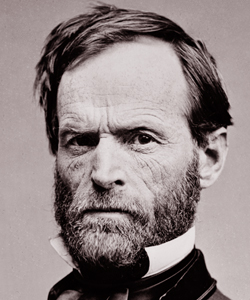 William Patrick Willey, Dickinson College Class of 1862, was determined to graduate even though all odds seemed to be against him. As a junior in college, Willey’s world erupted as his country went to war with itself after the battle of Fort Sumter on April 12, 1861. Ten days later Willey wrote his father, the future West Virginia senator Waitman T. Willey, of the precarious situation he was in as a Southern student in Carlisle, Pennsylvania. William sent two letters to his father within a one week period: one on April 22 and the second on April 29. Within this week William perceived that the situation in Carlisle had changed dramatically. In his first letter, William described the excited mobs of townspeople at the train station: “women bidding adieu to their husbands and sons.” Though a committee from the town approached the college’s president, Dr. Herman Merills Johnson, informing him that Southern students must either leave or take an oath of allegiance, William told his father that he would try to stay as long as he could: “I fear nothing yet. The only ones that are in danger are the students from S.C.” One week later, William and his friend McCants were the only Southern students left. Now however, Carlisle residents complimented William on his dedication for remaining at school. More often, William wrote, he and McCants were approached for their opinion as Southerners because “in Carlisle the prominent desire seems to be that of getting a hold on Jeff Davis.” William’s two letters document the remarkable shift in emotions of Carlisle residents after the immediate shock of Fort Sumter wore off—by April 29th it appeared that the women of Carlisle no longer felt it necessary to arm themselves with broomsticks against a possible Southern attack. After graduating, William P. Willey went on to earn his law degree and became a law professor at West Virginia University, where he founded the West Virginia Law Review in 1894.
William Patrick Willey, Dickinson College Class of 1862, was determined to graduate even though all odds seemed to be against him. As a junior in college, Willey’s world erupted as his country went to war with itself after the battle of Fort Sumter on April 12, 1861. Ten days later Willey wrote his father, the future West Virginia senator Waitman T. Willey, of the precarious situation he was in as a Southern student in Carlisle, Pennsylvania. William sent two letters to his father within a one week period: one on April 22 and the second on April 29. Within this week William perceived that the situation in Carlisle had changed dramatically. In his first letter, William described the excited mobs of townspeople at the train station: “women bidding adieu to their husbands and sons.” Though a committee from the town approached the college’s president, Dr. Herman Merills Johnson, informing him that Southern students must either leave or take an oath of allegiance, William told his father that he would try to stay as long as he could: “I fear nothing yet. The only ones that are in danger are the students from S.C.” One week later, William and his friend McCants were the only Southern students left. Now however, Carlisle residents complimented William on his dedication for remaining at school. More often, William wrote, he and McCants were approached for their opinion as Southerners because “in Carlisle the prominent desire seems to be that of getting a hold on Jeff Davis.” William’s two letters document the remarkable shift in emotions of Carlisle residents after the immediate shock of Fort Sumter wore off—by April 29th it appeared that the women of Carlisle no longer felt it necessary to arm themselves with broomsticks against a possible Southern attack. After graduating, William P. Willey went on to earn his law degree and became a law professor at West Virginia University, where he founded the West Virginia Law Review in 1894.
23
Jun
10
William P. Willey’s April 1861 letters
Posted by solnitr Published in Civil War (1861-1865), Letters & Diaries Themes: Carlisle & Dickinson23
Jun
10
Carlisle Fencibles
Posted by mckelveb Published in Civil War (1861-1865), Letters & Diaries, Rare Books Themes: Battles & Soldiers, Carlisle & Dickinson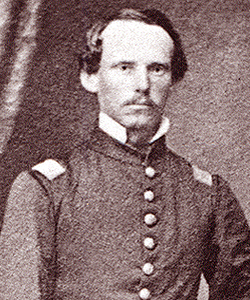 After the outbreak of the Civil War, four volunteer companies originally consisting of fifty to one hundred men were recruited in Carlisle, Pennsylvania on April 19, 1861. On April 21, the officers were chosen with Captain Robert M. Henderson, in charge of Company A of the 36th Regiment, 7th Pennsylvania Reserve Corps. Henderson was assisted in command by First Lieutenant James S. Colwell, Second Lieutenant Erkuries Beatty, and First Sergeant John D. Adair. These men received the nickname “Carlisle Fencibles” in part because most of its members belonged to a gymnastic club and because a “fencible” is a defender of a country. The company spent a two month period of relative inactivity marching and drilling until the soldiers left for Camp Wayne in West Chester, Pennsylvania on June 6. Before the men departed they received a satin flag from Mrs. Samuel Alexander, a granddaughter of Ephraim Blaine, that, according to David G. Colwell, had the inscription “May God defend the right!” The 7th Pennsylvania Reserves went on to fight in the Battles of Gaines’ Mill, Bull Run, and Antietam while suffering great losses. A more thorough description of the experiences of the company is available on Google Books in Samuel B. Bates’ History of Pennsylvania Volunteers, 1861-65 . The wartime experience of one member of the Carlisle Fencibles, John Taylor Cuddy, is chronicled through letters he sent home to his family in Carlisle. His correspondence is available as a part of Dickinson College’s “Their Own Words” digital archive which provides a picture of the experience of a young Carlisle Fencible during the Civil War.
After the outbreak of the Civil War, four volunteer companies originally consisting of fifty to one hundred men were recruited in Carlisle, Pennsylvania on April 19, 1861. On April 21, the officers were chosen with Captain Robert M. Henderson, in charge of Company A of the 36th Regiment, 7th Pennsylvania Reserve Corps. Henderson was assisted in command by First Lieutenant James S. Colwell, Second Lieutenant Erkuries Beatty, and First Sergeant John D. Adair. These men received the nickname “Carlisle Fencibles” in part because most of its members belonged to a gymnastic club and because a “fencible” is a defender of a country. The company spent a two month period of relative inactivity marching and drilling until the soldiers left for Camp Wayne in West Chester, Pennsylvania on June 6. Before the men departed they received a satin flag from Mrs. Samuel Alexander, a granddaughter of Ephraim Blaine, that, according to David G. Colwell, had the inscription “May God defend the right!” The 7th Pennsylvania Reserves went on to fight in the Battles of Gaines’ Mill, Bull Run, and Antietam while suffering great losses. A more thorough description of the experiences of the company is available on Google Books in Samuel B. Bates’ History of Pennsylvania Volunteers, 1861-65 . The wartime experience of one member of the Carlisle Fencibles, John Taylor Cuddy, is chronicled through letters he sent home to his family in Carlisle. His correspondence is available as a part of Dickinson College’s “Their Own Words” digital archive which provides a picture of the experience of a young Carlisle Fencible during the Civil War.
22
Jun
10
Outbreak of War at Dickinson College
Posted by rainwatj Published in Civil War (1861-1865), Letters & Diaries Themes: Carlisle & Dickinson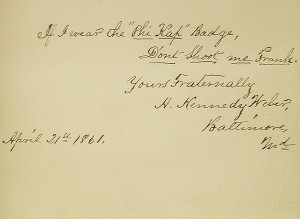 The Dickinson College student body was evenly divided between Northern and Southern students who fought on both sides of the conflict. The split is well documented in Dickinson College class of 1861 student Francis Benjamin Sellers’ Autograph Album for the Phi Kappa Sigma Fraternity. Taken from the Phi Kappa Sigma News Letter, Fall, 1954:
The Dickinson College student body was evenly divided between Northern and Southern students who fought on both sides of the conflict. The split is well documented in Dickinson College class of 1861 student Francis Benjamin Sellers’ Autograph Album for the Phi Kappa Sigma Fraternity. Taken from the Phi Kappa Sigma News Letter, Fall, 1954:
“On April 21, 1861, Epsilon held its last meeting shortly past midnight. All of the members gathered in the room of John. E McCahan and Francis B. Sellers in West College and dispensed with the usual forms of business so that the brothers could say their last farewells before leaving for their respective armies.”
Dickinson College students expected to encounter one another on the battlefield, which is reflected in the comments left in the autograph album. Howard Kennedy Weber class of 1863 remarked: “If I wear the “Phi Kap” badge, don’t shoot me Frank.”
Other Dickinson College students featured in Sellers’ album that fought in the conflict include fellow classmates Elbridge Hoffman Gerry, James Glasgow Archer, William Miller Ogilby and Ernest Dudley Martin.
22
Jun
10
The John Taylor Cuddy Correspondence
Posted by solnitr Published in Civil War (1861-1865), Letters & Diaries Themes: Battles & Soldiers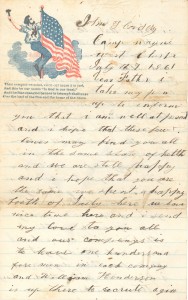 Sixteen-year-old John Taylor Cuddy left his home in Carlisle, Pennsylvania to enlist in Company A of the 36th Pennsylvania Infantry on June 5, 1861. Over the next two years, Cuddy wrote 77 letters home to his family describing his experiences as a soldier in the Union army. Cuddy’s correspondence is available online as part of Dickinson College’s “Their Own Words” digital archive. Over the course of his service in the army, Cuddy wrote his parents full of exuberance to go “lick the south” from his training camp at Fort Wayne, with a tempered tone of experience after fighting in the battle of Gaines’ Mill, and with a critical analysis of “old abe[‘s]” Emancipation Proclamation. At the Battle of the Wilderness, which lasted from May 5 to 7, 1864, Cuddy’s regiment was captured and sent to Andersonville, a Confederate prisoner of war camp in Georgia. With his capture, Cuddy’s letters stopped. Although John Taylor Cuddy never made it home to Pennsylvania (he died in a prison in Florence, South Carolina on September 29, 1864), his correspondence creates a living picture of the life of a teenage Pennsylvania soldier during the Civil War.
Sixteen-year-old John Taylor Cuddy left his home in Carlisle, Pennsylvania to enlist in Company A of the 36th Pennsylvania Infantry on June 5, 1861. Over the next two years, Cuddy wrote 77 letters home to his family describing his experiences as a soldier in the Union army. Cuddy’s correspondence is available online as part of Dickinson College’s “Their Own Words” digital archive. Over the course of his service in the army, Cuddy wrote his parents full of exuberance to go “lick the south” from his training camp at Fort Wayne, with a tempered tone of experience after fighting in the battle of Gaines’ Mill, and with a critical analysis of “old abe[‘s]” Emancipation Proclamation. At the Battle of the Wilderness, which lasted from May 5 to 7, 1864, Cuddy’s regiment was captured and sent to Andersonville, a Confederate prisoner of war camp in Georgia. With his capture, Cuddy’s letters stopped. Although John Taylor Cuddy never made it home to Pennsylvania (he died in a prison in Florence, South Carolina on September 29, 1864), his correspondence creates a living picture of the life of a teenage Pennsylvania soldier during the Civil War.
18
Jun
10
The Battle of Ball’s Bluff, October 21, 1861
Posted by rainwatj Published in Civil War (1861-1865), Images, Letters & Diaries, Maps, Places to Visit Themes: Battles & Soldiers The Battle of Ball’s Bluff, also known as the Battle of Harrison’s Island or Battle of Leesburg was fought on October 21, 1861 in Loudoun County, Virginia. In response to movement by Confederate Colonel Nathan G. Evans, Union Major General George B. McClellan ordered Brigadier General Charles P. Stone to conduct a “slight demonstration,” a show of force from the Maryland side of the Potomac River without the intention of having any troops cross or combat. After a small encounter with Confederate troops, Union soldiers were ordered to cross over the river into Virginia. Without the necessarily amount of boats, Union soldiers were unable to successfully engage the enemy. This poorly coordinated attack combined with a vigorous counterattack from Confederate soldiers led to a disastrous defeat for the Union including the death of Colonel Edward D. Baker, a United States Senator from Oregon. Estimated casualties for the Union Army totaled over 900 while the Confederates suffered only 150. The defeat had substantial political consequences in Washington D.C. with the establishment of the Congressional Joint Committee on the Conduct of the War.
The Battle of Ball’s Bluff, also known as the Battle of Harrison’s Island or Battle of Leesburg was fought on October 21, 1861 in Loudoun County, Virginia. In response to movement by Confederate Colonel Nathan G. Evans, Union Major General George B. McClellan ordered Brigadier General Charles P. Stone to conduct a “slight demonstration,” a show of force from the Maryland side of the Potomac River without the intention of having any troops cross or combat. After a small encounter with Confederate troops, Union soldiers were ordered to cross over the river into Virginia. Without the necessarily amount of boats, Union soldiers were unable to successfully engage the enemy. This poorly coordinated attack combined with a vigorous counterattack from Confederate soldiers led to a disastrous defeat for the Union including the death of Colonel Edward D. Baker, a United States Senator from Oregon. Estimated casualties for the Union Army totaled over 900 while the Confederates suffered only 150. The defeat had substantial political consequences in Washington D.C. with the establishment of the Congressional Joint Committee on the Conduct of the War.
Ted Ballard’s book Battle of Ball’s Bluff published by the U.S. Army Center of Military History provides the most extensive overview of the battle with a detailed account of the battle including maps, images, bibliographical sketches and further readings . The Library of Congress offers a number of resources including images of Baker’s death and the Union retreat. The Abraham Lincoln Papers at the Library of Congress is another valuable resource that contains transcribed military telegrams between generals and the President. The Ball’s Bluff Battlefield Regional Park and National Cemetery provides visitors a chance to explore the battle site with hiking trails and signs throughout the park. The Northern Virginia Regional Park Authority website also offers worthwhile information regarding the battle including an overview, cultural resources, a downloadable self guided audio tour and detailed battle maps.
18
Jun
10
The Battle of Wilson’s Creek, August 10, 1861
Posted by solnitr Published in Civil War (1861-1865), Letters & Diaries, Maps, Recent Scholarship Themes: Battles & Soldiers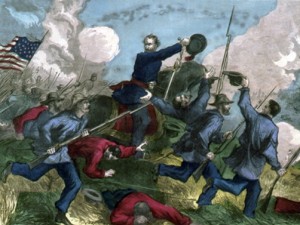 On August 10, 1861 about ten miles south of Springfield, Missouri Confederate forces under the joint command of General Benjamin McCulloch and Major General Sterling Price of the Missouri State Guard, defeated General Nathaniel Lyon’s Union troops at the battle of Wilson’s Creek. The National Park Service provides information geared towards teachers on their website, which highlights the field trip-friendly nature of the Wilson’s Creek battlefield. According to historian James McPherson, author of Battle Cry of Freedom, although the Confederate victory at Wilson’s Creek did not affect national public opinion, the battle had a direct impact on communities within Missouri. The Missouri State Senate officially declared Missouri’s secession from the Union on October 28, 1861, only three months after the battle at Wilson’s Creek. The Journal of the Missouri Senate’s Extra Session of the Rebel Legislature has been digitized as part of the Missouri Digital Heritage Initiative and is available here. Another rich online source for teachers exploring the Western theater of the Civil War is the website “Community and Conflict,” which documents the impact of the Civil War in the Ozarks from 1850 to 1875. By searching the Wilson’s Creek Collections researchers can access the journal of Captain Asbury C. Bradford of Company E, 2nd Regiment, 8th Division, Missouri State Guard, which includes Asbury’s hand-drawn map of the battle at Wilson’s Creek. Another unique resource is the memoir of Louisa Cheairs McKenny Sheppard, a 12-year-old resident of Springfield, who documented the effects of the Civil War on her family. The night before General Lyon was killed at Wilson’s Creek he dined at the McKenny home, an event that Louisa recorded in her memoir:
On August 10, 1861 about ten miles south of Springfield, Missouri Confederate forces under the joint command of General Benjamin McCulloch and Major General Sterling Price of the Missouri State Guard, defeated General Nathaniel Lyon’s Union troops at the battle of Wilson’s Creek. The National Park Service provides information geared towards teachers on their website, which highlights the field trip-friendly nature of the Wilson’s Creek battlefield. According to historian James McPherson, author of Battle Cry of Freedom, although the Confederate victory at Wilson’s Creek did not affect national public opinion, the battle had a direct impact on communities within Missouri. The Missouri State Senate officially declared Missouri’s secession from the Union on October 28, 1861, only three months after the battle at Wilson’s Creek. The Journal of the Missouri Senate’s Extra Session of the Rebel Legislature has been digitized as part of the Missouri Digital Heritage Initiative and is available here. Another rich online source for teachers exploring the Western theater of the Civil War is the website “Community and Conflict,” which documents the impact of the Civil War in the Ozarks from 1850 to 1875. By searching the Wilson’s Creek Collections researchers can access the journal of Captain Asbury C. Bradford of Company E, 2nd Regiment, 8th Division, Missouri State Guard, which includes Asbury’s hand-drawn map of the battle at Wilson’s Creek. Another unique resource is the memoir of Louisa Cheairs McKenny Sheppard, a 12-year-old resident of Springfield, who documented the effects of the Civil War on her family. The night before General Lyon was killed at Wilson’s Creek he dined at the McKenny home, an event that Louisa recorded in her memoir:
- “During dinner he [Lyon] raised his wine glass to Mother, and said, ‘Madam, you wish us success?’ ‘Sir,’ she answered with grave dignity, ‘I am a Southern woman.’ He looked at her in utter amazement, then said, ‘And you have sons in the Confederacy?’ Mother’s fine grey eyes were dark with trouble, as she made answer; ‘Four,’ then with a sudden flash of spirit, ‘and I wish they were fifty and I were leading them.’”
On August 10, 1861 about ten miles south of Springfield, Missouri Confederate forces under the joint command of General Benjamin McCulloch and Major General Sterling Price of the Missouri State Guard, defeated General Nathaniel Lyon’s Union troops at the battle of Wilson’s Creek. The National Park Service provides information geared towards teachers on their website, which highlights the field trip-friendly nature of the Wilson’s Creek battlefield. According to historian James McPherson, author of Battle Cry of Freedom, although the Confederate victory at Wilson’s Creek did not affect national public opinion, the battle had a direct impact on communities within Missouri. The Missouri State Senate officially declared Missouri’s secession from the Union on October 28, 1961, only three months after the battle at Wilson’s Creek. The Journal of the Missouri Senate’s Extra Session of the Rebel Legislature has been digitized as part of the Missouri Digital Heritage Initiative and is available here. Another rich online source for teachers exploring the Western theater of the Civil War is the website “Community and Conflict,” which documents the impact of the Civil War in the Ozarks from 1850 to 1875. By searching the Wilson’s Creek Collections researchers can access the journal of Captain Asbury C. Bradford of Company E, 2nd Regiment, 8th Division, Missouri State Guard, which includes Asbury’s hand-drawn map of the battle at Wilson’s Creek. Another unique resource is the memoir of Louisa Cheairs McKenny Sheppard, a 12-year-old resident of Springfield, who documented the effects of the Civil War on her family. The night before General Lyon was killed at Wilson’s Creek he dined at the McKenny home, an event that Louisa recorded in her memoir:
“During dinner he [Lyon] raised his wine glass to Mother, and said, ‘Madam, you wish us success?’ ‘Sir,’ she answered with grave dignity, ‘I am a Southern woman.’ He looked at her in utter amazement, then said, ‘And you have sons in the Confederacy?’ Mother’s fine grey eyes were dark with trouble, as she made answer; ‘Four,’ then with a sudden flash of spirit, ‘and I wish they were fifty and I were leading them.’”
16
Jun
10
General Sherman’s March to the Sea (November – December 1864)
Posted by sailerd Published in Civil War (1861-1865), Images, Letters & Diaries, Maps Themes: Battles & SoldiersGeneral William T. Sherman’s March to the Sea, also known as the Savannah Campaign, began on November 15 when Sherman’s forces left Atlanta, Georgia. The Confederate defeat at Savannah on December 21, 1864 marked the end of the campaign. Teachers can find an overview of this campaign in Professor Anne Bailey’s entry on the New Georgia Encyclopedia. The Library of Congress also has a number of related resources, including battle maps, photographs, and illustrations. In addition, the Digital Library of Georgia has all of the images from Barnard’s Photographic Views of the Sherman Campaign (1866), including several pictures of Savannah. Lt. Cornelius C. Platter’s diary, which was noted in an earlier post, is another resource that offers an interesting perspective on a Union officer’s experience. Platter, who served with the 81st Ohio Infantry Volunteers, added an entry on almost every day of the campaign. As his company prepared for their “marching orders” in early November, Platter described:
“Many different opinions have been expressed as to our probable destination – Some think we will make direct for Charleston S.C. others that we will visit Mobile – but the most general belief is that Savannah will be the objective point – Nothing definite however is known concerning the coming movement. Received orders this evening to move at six o’clock tomorrow morning – All tents and other government property which we can not take with us to be left standing undisturbed.”
continue reading "General Sherman’s March to the Sea (November – December 1864)"
16
Jun
10
Battle of Cold Harbor, May 31-June 12, 1864
Posted by mckelveb Published in Civil War (1861-1865), Images, Letters & Diaries, Maps, Recent Scholarship Themes: Battles & SoldiersThe Battle of Cold Harbor (also known as Second Cold Harbor) took place in Hanover County, Virginia from May 31-June 12, 1864. As a part of the overland campaign to Richmond of 1864 General Robert E. Lee and the Confederate Army of Northern Virginia defeated Ulysses S. Grant and the Army of the Potomac. On June 3, the Union II, XVIII, and IX Corps attacked the Confederates at the Bethesda Church-Cold Harbor line and were massacred. The casualties sustained by the Union Army led Grant to say that “this charge seemed to revive [Confederate] hopes temporarily.” The National Park Service’s website provides an overview of the battle that recounts the day to day activity of the fighting as well as a list of Union and Confederate troops present at the battle. The National Parks Service’s website also includes a list of suggested readings for teachers and offers interactive travel trunks that are available for loan to classes. There is a link available that presents visitors with a map of different stops throughout a tour of the battlefield and gives suggestions for teachers to plan a fieldtrip to the battleground. The Civil War Preservation Trust ’s website has links to suggested readings, online resources, and battle facts about the events at Cold Harbor. The site includes a map that details the plan of battle for the Union and Confederate forces. Another resource that may be interesting to browse is Gordon C. Rhea’s Cold Harbor: Grant and Lee, May 26-June 3, 1864 , available in limited view on Google Books, which gives a rather detailed preview regarding the events of the battle. Grant commented on the battle in his memoirs:
“I have always regretted that the last assault on Cold Harbor was ever made. I might say the same thing of the assault of the 22 of May, 1863, at Vicksburg. At Cold Harbor no advantage was ever gained to compensate for the heavy loss we sustained. Indeed, the advantages other than those of relative losses, were on the Confederate side.”
15
Jun
10
The Sinking of the CSS Alabama, June 19, 1864
Posted by solnitr Published in Civil War (1861-1865), Images, Letters & Diaries, Rare Books, Recent News Themes: Battles & Soldiers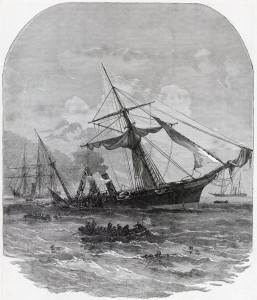 On the morning of June 19, 1864, before the naval battle with the USS Kearsarge Captain Raphael Semmes of the CSS Alabama, in an impassioned address, spoke to his crew:
On the morning of June 19, 1864, before the naval battle with the USS Kearsarge Captain Raphael Semmes of the CSS Alabama, in an impassioned address, spoke to his crew:
- “you have been all over the world and it is not too much to say that you have destroyed and driven for protection under neutral flags one half of the enemy’s commerce which at the beginning of the war covered every sea This is an achievement of which you may well be proud and a grateful country will not be unmindful of it The name of your ship has become a household word wherever civilization extends Shall that name be tarnished by defeat The thing is impossible Remember that you are in the English Channel the theatre of so much of the naval glory of our race and that the eyes of all Europe are at this moment upon you The flag that floats over you is that of a young Republic who bids defiance to her enemies whenever and wherever found Show the world that you know how to uphold it.”
Semmes recorded his personal experiences as the captain of CSS Alabama and Sumter in his personal memoir My Adventures Afloat … (1869), available on Google Books. Captain Semmes’ stirring speech did not stop the USS Kearsarge on June 19, 1684 from sinking the Alabama and putting an end to her formidable record. In less than two years the CSS Alabama, a Confederate ship that engaged in commerce raiding by destroying Union merchant ships, sunk 62 ships including the USS Hatteras. The Naval History & Heritage Command, an agency of the Department of the Navy, outlines the history of the ship in an educational website that includes a wide range of resources for classroom use. Students can view images of the battle as published in contemporary newspapers, read excerpts from the official reports of both the Union Captain John Winslow and the Confederate Captain Semmes, or explore recent press releases about the underwater archaeological work being conducted on the wreck since its discovery in 1988 off the coast of France. For other resources, see Historyofwar.org , where they provide maps of the CSS Alabama’s routes and of the battle with the USS Kearsarge.
[flickrslideshow acct_name=”housedivided” id=”72157624282521058″]
15
Jun
10
The Battle of Olustee (Ocean Pond): February 20, 1864
Posted by rainwatj Published in Civil War (1861-1865), Historic Periodicals, Images, Letters & Diaries, Maps, Places to Visit Themes: Battles & Soldiers The Battle of Olustee took place on February 20, 1864 in Baker County, Florida where the Union Army under Brigadier General Truman B. Seymour was defeated and forced to retreat back to Jacksonville in the largest battle fought in Florida during the American Civil War. Under Brigadier General Joseph Finegan, the reinforced Confederate soldiers inflicted massive casualties on Union troops. Estimates on both sides list the total casualties for the Union Army at 1,860, almost 40% of the participating soldiers and 946 Confederate casualties, 20% of their soldiers at Olustee. Seymour’s army was notable for the participation of three colored regiments; the 8th United States Colored Troops, the 35th United States Colored Troops and the 54th Massachusetts Infantry. For more information on these regiments during Olustee, check out portions of J. Matthew Gallman’s chapter in Wars within a War: Controversy and Conflict over the American Civil War. Other documents of interest related to the Battle of Olustee can be found in volume 35 of the Official Records.
The Battle of Olustee took place on February 20, 1864 in Baker County, Florida where the Union Army under Brigadier General Truman B. Seymour was defeated and forced to retreat back to Jacksonville in the largest battle fought in Florida during the American Civil War. Under Brigadier General Joseph Finegan, the reinforced Confederate soldiers inflicted massive casualties on Union troops. Estimates on both sides list the total casualties for the Union Army at 1,860, almost 40% of the participating soldiers and 946 Confederate casualties, 20% of their soldiers at Olustee. Seymour’s army was notable for the participation of three colored regiments; the 8th United States Colored Troops, the 35th United States Colored Troops and the 54th Massachusetts Infantry. For more information on these regiments during Olustee, check out portions of J. Matthew Gallman’s chapter in Wars within a War: Controversy and Conflict over the American Civil War. Other documents of interest related to the Battle of Olustee can be found in volume 35 of the Official Records.
The most extensive collection of resources can be found at the Battle of Olustee site developed by Thomas R. Fasulo which includes primary sources such as official reports, maps, letters, diaries, images, speeches and periodicals. The Olustee Battlefield Historic State Park commemorates the battle and offers visitors a chance to immerse themselves through walking tours of the battlefield and a visitor center with historical information and artifacts. There is an annual reenactment of the battle in February and a Civil War Expo in September that provides visitors an authentic experience of the battle with hands on activities and historical reenactments
